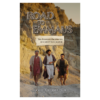Natural history museums everywhere display line-ups of ape-to-human icons that supposedly show how humans evolved from ape-like creatures millions of years ago. After the icon named “Ardi,” which evolutionists place in the “4 to 5 million years ago” time slot, the next ape-to-human icon is Australopithecus afarensis, with the leading specimen named “Lucy.”
To create the Lucy icon we see in museums, scientists took hundreds of bone pieces found scattered over a nine-foot area and glued them together to make 47 skeletal parts. Even though they sifted through 20 tons of sediment covering a 160-square foot area they only found about 20% of her bones if you count hand and feet bones, and they didn’t find any of those, except a tiny finger bone (see Figure 9).[i]

This doesn’t stop Lucy from being displayed in school textbooks with complete, human-looking feet (see Figure 10).

To further exaggerate Lucy’s human-like appearance, some Lucy models don’t even have body hair! (see Figure 11).

There’s no way to tell if all these bones are from the same creature, and they recently learned that at least one of Lucy’s bones actually belonged to an extinct type of baboon. While this vertebra didn’t even belong to Lucy or her kind, it’s still included in Lucy displays all over the world.
In 2015, press releases started coming out and showing that, even after 40 years of study involving hundreds of scientists, one of Lucy’s bones (a vertebra) didn’t even belong to her (see Figure 12).[iv] In fact, it didn’t even belong to Lucy’s species, but was from a Theropithecus, a type of extinct baboon. Does that make you wonder if we’re really dealing with bones from a single individual with Lucy? Especially when Lucy was put together from hundreds of bone fragments that were found scattered along a hillside?[v]
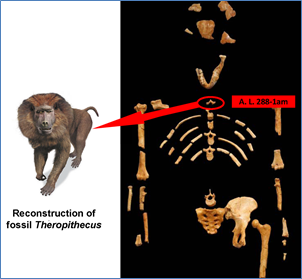
They believe Lucy was an adult female that weighed 55 to 65 pounds and stood 3-1/2 feet tall—right about the same size as today’s chimps or bonobos.[vii] After gluing Lucy’s hundreds of bone pieces into 47 parts and creating models of what they think Lucy looked like, evolutionists came up with some surprisingly human-like creatures, with most models even including complete hands and feet (even though they didn’t find Lucy’s hands or feet).

Most Lucy models even include white sclera on the eyes, which no apes have, except for some that have a small rim of eye whites. This sure exaggerates Lucy’s human-like appearance in museum displays and books. Lucy’s complete head and skull are shown in museums and school textbooks across America, but all they found of her skull were just the few brown pieces shown in Figure 14. All the rest is imagination.
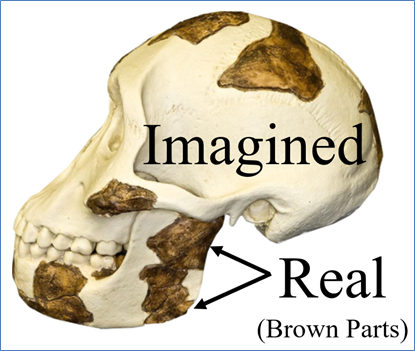
As leading paleo expert Dr. Leakey noted: “Lucy’s skull was so incomplete that most of it was imagination made of plaster of Paris, thus making it impossible to draw any firm conclusion about what species she belonged to.”[x]

Notice Lucy’s skull is sloped and ape-like. It’s also the size and shape that closely resembles a modern bonobo (a cousin to the chimp). Lucy’s brain was just one third the size of a human’s, making it the same size as the average chimp’s.[xii] Paleo expert Dr. Zuckerman said that “The Australopithecine skull is in fact so overwhelmingly ape-like, as opposed to human that the contrary position could be equated to an assertion that black is white.”[xiii]
The foramen magnum is the hole in the bottom of the skull where the top of the spinal cord enters. The angle at which the spinal cord entered the foramen magnum of Lucy’s species is nearly identical to a chimp’s—indicating that Lucy’s species walked hunched-over on all fours.[xiv]

One study conducted by evolutionary scientists showed that the angle of the foramen magnum of Lucy’s species was “well below the range for our sample of modern humans but overlaps the low end of the range for position between modern apes and humans, but closer to the former (chimpanzees, specifically).”[xvi]
Evolutionists claim that Lucy supposedly walked upright like humans. But how could this be true when her spine entered the base of her skull at an angle just like chimps today, putting her into a hunched over position? And her face was just as sloped as chimps today—so even if she tried walking upright and looked down, she’d be looking at her nose! Chimps can walk upright, but only for short distances. Our spines enter into the middle of the base of our skulls at a relatively straight angle so we can walk upright with ease, turning our heads as we walk. But in both chimps and Lucy’s kind, the spine enters more toward the rear of the skull and comes in slanted, forcing her to walk hunched over so she could see where she’s going.
Skull scans of Lucy’s kind have found another big problem with the idea that they walked upright. They found that their inner ears resemble those of African apes today[xvii] and were “more like chimps than modern humans,” leaving even evolutionary scientists to admit her kind was best suited for “facultative bipedalism,”[xviii] or walking occasionally on two feet like chimps do today.[xix]
Humans have three semicircular canals embedded deep within our ears that are integrated with our brains, heads, and eyes to keep us balanced as we move. Apes’ semicircular canals orient to their up-tilted heads. To investigate how these semicircular canals are involved in the movement of various creatures, scientists have studied them in depth using advanced scanning techniques and making measurements of their different structures. Australopithecines, as well as other living and non-living apes, all have semicircular canals that fit ape-oriented heads that fit bodies designed for walking on all fours, whereas humans semicircular canals match upright, two-legged locomotion.

In particular, they learned that the semicircular canals of australopithecines were best suited for “facultative bipedalism,”[xxi] which means walking occasionally on two feet, just like many apes walk today. While this study focused on Australopithecus africanus—and Lucy’s species has been labeled Australopithecus afarensis—they are anatomically similar.[xxii]
What about Lucy’s species specifically? Dr. Bernard Wood conducted a study that revealed that the semicircular canals of Lucy’s species “were more like those of chimpanzees than of modern humans. The fluid-filled semicircular canals are crucial in maintaining balance, and so all three lines of evidence suggest that the locomotion of Australopithecus afarensis was unlikely to have been restricted to walking on two feet”[xxiii] (emphasis added).
Another report in the leading secular science journal Scientific American[xxiv] reviewed the research conducted on a baby Australopithecus afarensis, stating: “Using computed tomographic imaging, the team was able to glimpse her semicircular canal system, which is important for maintaining balance. The researchers determined that the infant’s semicircular canals resemble those of African apes and another australopithecine, A. africanus. This, they suggest, could indicate that A. afarensis was not as fast and agile on two legs as we modern humans are.”
One fascinating aspect of semicircular canals is that, while they all work together, each of them provides a separate sense of directional balance: “The superior canal [or anterior canal] detects head rotations on the anterior-posterior (side-to-side movement, like tilting the head toward the shoulders) axis. The posterior canal detects rotations on the sagittal plane (forward and backward movement, like doing sit-ups). The horizontal canal senses movement on a vertical basis, as the head rotates up-and-down on the neck.”[xxv]
It just so happens that the two same canals that are most involved for helping us walk upright are the two canals that are statistically significantly different[xxvi] between humans and chimps. Lucy’s species clearly identifies with chimps. Dr. Spoor noted that two of the three semicircular canals in particular coordinate “upright bipedal behavior” because they are involved in “movements in the vertical plane” (i.e., upright walking).[xxvii] Drs. Day and Fitzpatrick agree with this, stating: “The anterior and posterior canals of the human vestibular organs are enlarged in size relative to the horizontal canal whereas the three canals are more equal in size in other species. The significance of this is that the anterior and posterior canals are orientated to sense rotation in the vertical planes, the movements that are important for controlling upright balance”[xxviii] (emphasis added).

What difference does this make? Well, think about it this way: If you had your semicircular canals surgically replaced with a chimp’s, at the very least, you’d be really disoriented! Your head would feel level only when you were looking to the sky. You wouldn’t be able to run with as much ease as you have now, since the same two semicircular canals that are significantly different between apes and humans help stabilize your head when running.[xxix]
Next, we’ll take a look at the fingers of Lucy’s species. Comparison of various apes, humans, and Lucy’s species’ finger curvatures reveal some major differences. Even evolutionary scientists have admitted that the curved fingers of Lucy’s species were best suited for swinging in trees.[xxx] One study statistically compared various finger measurements from several different types of apes against humans, and grouped the fingers of Lucy’s species in the same category as chimps and bonobos, and far away from human’s straight fingers (see Figures 19 and 20).

Figure 20 shows a finger from one of Lucy’s species, showing significant curvature compared to human fingers, which are not curved.
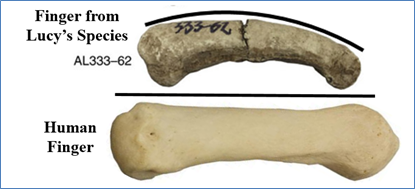
Other examples of australopithecine apes had curved fingers and ape-like limb proportions that point toward her kind as living in trees, so the same was probably true of Lucy.[xxxiii]

Lucy had a locking wrist system for walking on all fours. This locking system included ledges and notches that are classic features for knuckle-walking apes and are not found in humans.[xxxiv] This has been widely reported in both scientific journals as well as the general media. For example, even the San Diego Union Tribune reported, “A chance discovery made by looking at a cast of the bones of ‘Lucy,’ the most famous fossil of Australopithecus afarensis, shows her wrist was stiff, like a chimpanzee’s, Brian Richmond and David Strait of George Washington University in Washington, D.C., reported. This suggests that her ancestors walked on their knuckles.”[xxxv] The study conducted by these scientists concluded: “Measurements of the shape of wristbones (distal radius) showed that Lucy’s type were knuckle walkers, similar to gorillas.”[xxxvi]
When interviewed about their study (published in Nature) they stated: “It suddenly occurred to me that paleoanthropologists had never looked at the wrists of Lucy or other important early human ancestors discovered since the early papers were published….” so while they were visiting the Smithsonian, they went to the cast collection, inspected Lucy’s radius [forearm bone], and found that she had the “classic knuckle-walking feature.” This became obvious when they “saw a ridge of bone on the lower forearm that prevented Lucy’s wrist, like that of a chimpanzee or gorilla, from rocking backward, but allowed it to lock in an upright position for easy knuckle-walking.”[xxxvii] Figure 22 highlights this “locking wrist” feature they found on Lucy’s bones.

The study conducted by Richmond and Strait revealed that Lucy had the same concave arm bone that joined with her convex wrist, creating a locking system that allowed for both swinging and stable knuckle-walking (as shown in Figure 23).

Figure 23 shows a close-up view from the study. The arm bone on the far left is from Lucy; the one in the middle is from a chimp; and the one on the far right is human. Notice how Lucy’s bone matches the chimp’s—they both have the convex shape that allows the wrist to lock into place for knuckle walking. Humans do not have any angle for this whatsoever because we’re not designed for walking on our hands!
Next, on to Lucy’s feet. One of the most profound stretches made by evolutionists involve Lucy’s missing feet and the Laetoli footprints that were found 1,000 miles away from where Lucy was excavated. Remember, they didn’t even find Lucy’s feet—and all the foot bones they believe are from Lucy’s kind can fit into a small lunch box. But this doesn’t stop natural history museums from showing Lucy walking around with perfectly human feet and claiming that Lucy’s kind made the footprints, even though they widely admit the footprints look exactly like a human’s. Just how was Lucy—or her friends or cousins—supposed to make these footprints when the footprints look completely human, with some of them over 10 inches long?[xl] That’s a size 9.5 shoe and a person that was likely 5 feet 9 inches tall. Remember—Lucy was only three and a half feet tall. Even if these footprints were made by a massive male of Lucy’s kind that was five-nine with huge 10-inch feet, that’s 65% taller than Lucy. How much sense does that make—especially when males and females of Lucy’s closest look-alike today—bonobos—are about the same height?[xli] That’s putting some big, human-looking feet on this little creature! It sounds more like the human footprints were made by humans, and the dating timeline is off—way off.
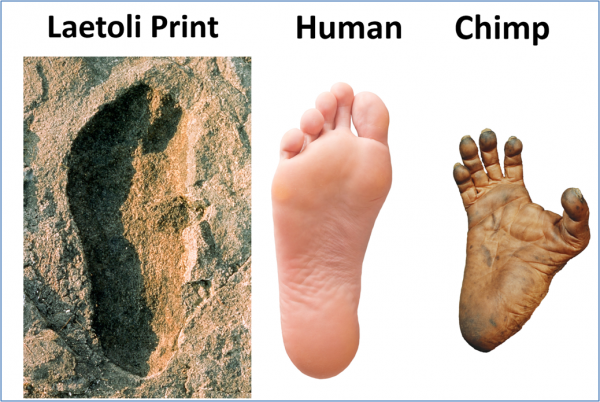
They also found 13 fossils in that region which they classified in the genus Homo because they looked human-like.[xliii] So… if the footprints look unmistakably human and human-looking bones were found closer to the footprints than Lucy’s kind, wouldn’t it make more sense that the footprints were actually made by humans?
In fact, anatomically modern human footprints were just found in western Crete that “dated” to 5.7 million years old.[xliv] The article states: “At approximately 5.7 million years old, they are more than a million years older than Ardipithecus ramidus with its ape-like feet. This conflicts with the hypothesis that Ardipithecus is a direct ancestor of later hominins.” These human footprints pre-date both Ardi and Lucy. It sure seems like the ape-to-man story doesn’t line up with deep time, with these footprints dating to a time before upright walking was supposed to happen. It’s more likely that these ape-like creatures died in ice age flooding just thousands of years ago.
So—to recap: Lucy is based on hundreds of bone pieces glued together to make a fragmented skeleton with about 20% of her bones. She was pulled out of 20 tons of sifted dirt over a 160-foot area. She was the size and weight of a chimp or bonobo, had a brain the size of a chimp, and inner ears for balancing like a chimp—not walking like humans. And somehow—after she’s paraded around in museums and school textbooks for 20 years—they find out that she has a vertebra of an extinct baboon and locking wrists like other apes. Today scientists are still arguing about basic things—like even her gender, publishing articles like “Lucy or Lucifer?[xlv] and “Lucy or Brucey?”[xlvi]
Just a few years ago CNN reported on a study that showed Lucy most likely died by falling 40 feet out of a tree, traveling at 35 miles per hour when she hit the ground![xlvii] So what’s this little ape—that was supposedly walking upright—doing 40 feet up in a tree? That’s ironic. Yet when millions of students every year see Lucy in museums and textbooks, she is shown with complete, human-like hands and feet, human-like eyes, and walking upright with human-like gazes and poses. Sometimes they even remove Lucy’s body hair, trying to make her appear even more humanlike (see Figure 11). There’s a whole line-up of secular paleo experts who have similar concerns about Lucy. Dr. Oxnard in the The Order of Man wrote “Australopithecines … are now irrevocably removed from a place in the evolution of human bipedalism … All this should make us wonder about the usual presentation of human evolution in introductory textbooks.”[xlviii] Dr. Herbert says that his fellow paleoanthropologists “compare the pygmy chimps to ‘Lucy,’ one of the oldest hominid fossils known, and finds the similarities striking. They are almost identical in body size, in stature and in brain size.”[xlix]
So… just what was Lucy? Lucy and other australopithecines are extinct apes—just like many other ape species that have gone extinct. She walked on all fours, ate the foods that apes eat, and lived among other animals that are like those that live around apes today, including 87 other animal species, such as elephants, antelope, rhino, hippos, and numerous other African animals.
[i] While almost every museum and book replicas of Lucy’s skeleton do not show any foot or toe bones, Dr. Carl Morgan interviewed Dr. Donald Johanson in Arizona and photographed the copy of the reassembled Lucy skeleton and the two foot bones can be seen but only close up as they are suspended by a wire. Dr. Morgan also photographed these two toe bones on the Lucy skeleton on display at the Chicago field museum.
[ii] Image credit: Australopithecus afarensis (History Alive! The Ancient World. Palo Alto, CA: Teachers Curriculum Institute, 2004.
[iii] Licensed through Alamy. Photo Credit Franck Robichon/epa/Corbis.
[iv] Meyer, Marc R., Williams, Scott A, Smith, Michael P., Sawyer, Gary J. “Lucy’s back: Reassessment of fossils associated with the A.L. 288-1 vertebral column.” Journal of Human Evolution, 85 (August 2015): 174–180.
[v] Personal communication: “All [Lucy’s bones were] found in an area covering about 3 square meters.” Donald Johanson (May 28, 2014).
[vi] “Archaeological surprise! Lucy has company,” November 30, 2015. Atlas of Science. https://atlasofscience.org/archaeological-surprise-lucy/. Accessed January 27, 2017.
[vii] “What Does it Mean to be Human? (Australopithecus afarensis).” Smithsonian National Museum of Natural History. https://humanorigins.si.edu/evidence/human-fossils/species/australopithecus-afarensis. Accessed September 22, 2020.
[viii] Image credit: Answers in Genesis (left); Brian Thomas (right).
[ix] Skull from: www.skullsunlimited.com
[x] Leakey, Richard. The Weekend Australian. (May 7–8, 1983): 3.
[xi] Ibid.
[xii] Time magazine reported in 1977 that Lucy had a tiny skull, a head like an ape, a braincase size the same as that of a chimp—450 cc. and “was surprisingly short legged” (Time, November 7, 1979, pp. 68–69). See also: Smithsonian National Museum of Natural History, “Australopithecus afarensis”: https://humanorigins.si.edu/evidence/human-fossils/species/australopithecus-afarensis (September 2, 2015).
[xiii] Zuckerman, Solly. Beyond the Ivory Tower. London: Taplinger Publishing Company, 1970: 78.
[xiv] Kimbel, William H. & Rak, Yoel. “The Cranial Base of Australopithecus afarensis: New Insights from the Female Skull.” Philosophical Transactions of the Royal Society B: Biological Sciences 365.1556 (2010): 3365–3376.
[xv] Upper Image credit: Wolpoff, M. H., Hawks, J., Senut, B., Pickford, M., Ahern, J., “An Ape or the Ape: Is the Toumaï Cranium TM 266 a Hominid?” PaleoAnthropology. 2006: 36–50 (upper two images, arrows added). Lower Image credit: Evolution Facts, Inc. Evolution Encyclopedia Volume 2, Chapter 18 Ancient Man. www.godrules.net/evolutioncruncher/2evlch18a.htm. Accessed January 27, 2017. FM differences discussed in: Kimbel, William H. & Rak, Yoel. “The Cranial Base of Australopithecus afarensis: New Insights from the Female Skull.” Philosophical Transactions of the Royal Society B: Biological Sciences 365.1556 (2010): 3365–3376.
[xvi] Ibid., 3369–3370
[xvii] Wong, Kate, “Special Report: Lucy’s Baby An extraordinary new human fossil comes to light,” Posted September 20, 2006. Scientific American. www.scientificamerican.com/article/special-report-lucys-baby/ Accessed January 27, 2017.
[xviii] Spoor, Fred, Wood, Bernard, Zonneveld, Frans. “Implications of Early Hominid Labyrinthine Morphology for Evolution of Human Bipedal Locomotion,” Nature 369 (June 23, 1994): 645–648.
[xix] Wood, Bernard, “A precious little bundle,” Nature 443 (September 21, 2006): 278–281.
[xx] Image credit: Wikipedia.
[xxi] Spoor et al., 1994, 645–648.
[xxii] Smithsonian National Museum of Natural History. What Does it Mean to be Human (Australopithecus afarensis). https://humanorigins.si.edu/evidence/human-fossils/species/australopithecus-afarensis. Accessed September 22, 2020.
[xxiii] Wood, 2006.
[xxiv] Wong, Kate. “Special Report: Lucy’s Baby An extraordinary new human fossil comes to light,” Scientific American: www.scientificamerican.com/article/special-report-lucys-baby/. September 20, 2006. Accessed January 27, 2017.
[xxv] Healthline Bodymaps: www.healthline.com/human-body-maps/semicircular-canals. Medically Reviewed on January 26, 2015 by Healthline Medical Team (January 27, 2017).
[xxvi] Spoor, F. & Zonneveld, F. “Comparative review of the human bony labyrinth,” Am J Phys Anthropology, Supplement 27 (1998): 211–51.
Gunz, P. et al., “The Mammalian Bony Labyrinth Reconsidered: Introducing a Comprehensive Geometric Morphometric Approach,” Journal of Anatomy 220, 6 (2012): 529–543.
[xxvii] Spoor, 1994, 645–648.
[xxviii] Day, Brian L., et al. “The vestibular system,” Current Biology, 15 (15), R583–R586.
[xxix] Summers, Adam, “Born to Run: Humans will Never Win a Sprint against your Average Quadruped. But our Species is well-adapted for the Marathon.” September 1, 2015. Biomechanics. www.naturalhistorymag.com/biomechanics/112078/born-to-run. Accessed September 23, 2020.
[xxx] Domínguez-Rodrigo, Manuel, Pickering, Travis Rayne, Almécija, Sergio, Heaton, Jason L., Baquedano, Enrique, Mabulla, Audax & Uribelarrea, David. “Earliest modern human-like hand bone from a new >1.84-million-year-old site at Olduvai in Tanzania,” Nature Communications 6 (2015): 7987; Stern, Jack & Susman, Randall L. “The Locomotor Anatomy of Australopithecus afarensis,” Journal of Physical Anthropology 60 (1983): 280.
[xxxi] Ibid.
[xxxii] Ibid.
[xxxiii] Stern & Susman, 1983, 280.
[xxxiv] Richmond, Brian G. & Strait, David S. “Evidence That Humans Evolved from a Knuckle-Walking Ancestor,” Nature, 404 (2000): 382–385.
[xxxv] Fox, Maggie, “Man’s Early Ancestors Were Knuckle Walkers,” San Diego Union Tribune (Quest Section) (March 29, 2000).
[xxxvi] Richmond & Strait, 2000, 382–385.
[xxxvii] Gugliotta, Guy. “It’s All in the Wrist Early Human Ancestors Were ‘Knuckle-Walkers,’ Research Indicates.” Washington Post (March 23, 2000): A03.
[xxxviii] Richmond & Strait, 2000, 382–385.
[xxxix] Ibid.
[xl] See discussion and citations in: Rupe, Christopher & Sanford, John. Contested Bones. FMS Publications (2020): 136.
[xli] Encyclopedia Britannica online. www.britannica.com/animal/bonobo. Accessed September 22, 2020.
[xlii] Dalton, Rex. “Fears for oldest human footprints: Fossilized tracks pose preservation puzzle.” Nature News. 451, 118 (2008). Nature.com. January 9,
Accessed September 22, 2020.
[xliii] See Contest Bones (2020), p. 134 and Leakey, M.D., Hay, R. L., Curtis, G. H., Drake, R.E., Jackes, M. K., White, T. D., Fossil hominids from the Laetolil beds. Nature 262 (1976): 460–466.
[xliv] Gierlinski, G.D. et al. “Possible hominin footprints from the late Miocene (c. 5.7 Ma) of Crete?” Proceedings of the Geologists’ Association, 621 (2017): 1–14.
[xlv] Tague, R.G. & Lovejoy C.O. “AL 288-1–Lucy or Lucifer: gender confusion in the Pliocene.” Journal of Human Evolution 35 (1) (June 20, 1998): 75–94; Häusler, M. & Schmid, P. “Comparison of the Pelves of Sts 14 and AL 288-1: Implications for Birth and Sexual Dimorphism in Australopithecines.” Journal of Human Evolution 29 (1995): 363–383.
[xlvi] Boyle, Alan. “Lucy or Brucey? It Can Be Tricky to Tell the Sex of Fossil Ancestors,” Science (April 29, 2015).
[xlvii] “UT Study Cracks Coldest Case: How the Most Famous Human Ancestor Died.” Posted August 29, 2016. UT News. https://news.utexas.edu/2016/08/29/ut-study-cracks-coldest-case-how-lucy-died (January 27, 2017).
[xlviii] Oxnard, C. The Order of Man: A Biomathematical Anatomy of the Primates, Yale University Press, September 10, 1984: 332.
[xlix] Wray, Herbert, “Lucy’s Uncommon Forbear,” Science News 123 (February 5, 1983): 89.

